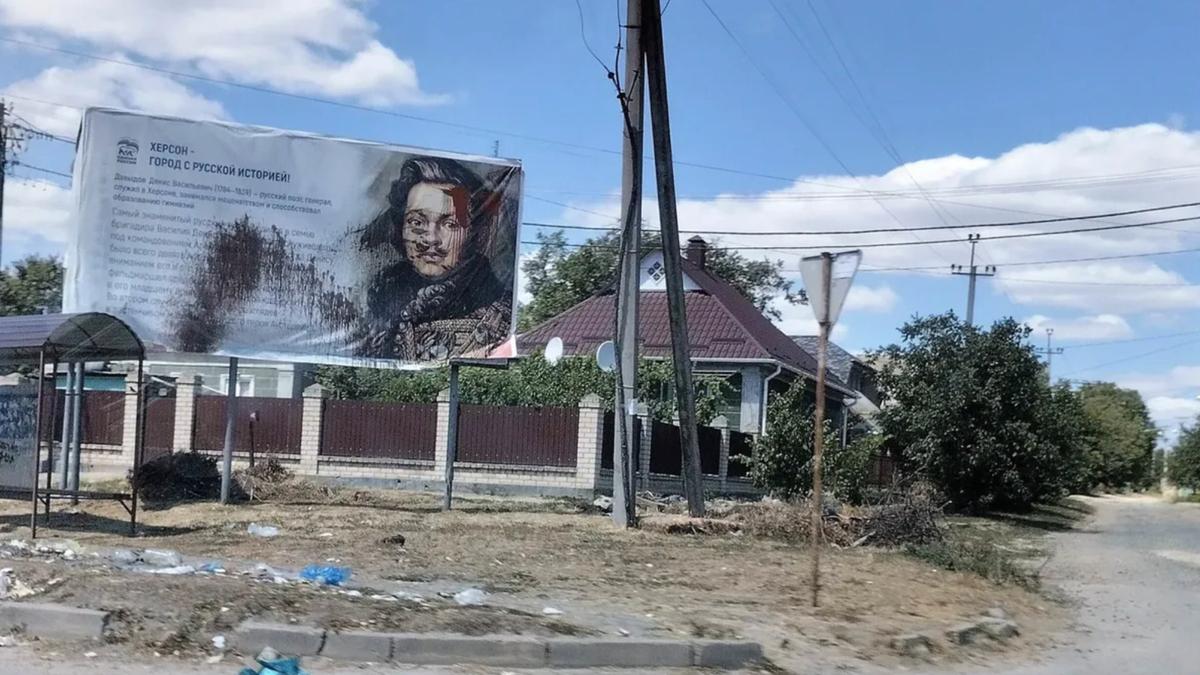“I was watering my garden,” says Marya, a 30-year-old resident of Kherson. “I bent down to rearrange my hose. Suddenly, I heard sounds coming from the sky; it was a missile! And some new type, too. A scary one. I dropped the hose and I stormed towards the basement like they do in the movies, running over five patches at once; it took me just one second to get there. The blast was completely wild. The missile came from HIMARS (American high mobility artillery rocket system, after the start of the war in Ukraine, the Pentagon provided Ukraine with several shipments of this weapon — editor’s note), they were striking the Antonivskyi Bridge…”
Marya’s house stands near a former university building, which hides behind a tall fence. Military vehicles get inside and outside the facility quite often, which makes Marya worry that one day a missile might hit one of the neighbouring buildings, and her home would be destroyed.
The border
Officially, there are no humanitarian corridors to escape the Kherson region, occupied by Russia at the end of February. People migrate to the territory controlled by Ukraine through the partly occupied Zaporizhzhia region. But that road is constantly getting shelled, and it is not rare that the refugees trying to escape Kherson are killed. There is another way to evacuate — to Russia or to Europe through Crimea. This route is considered somewhat safe. There is bus traffic between Crimea and the Kherson region, though one has to buy a ticket in advance on a website. The passengers are required to share their ID data to purchase the tickets.
One can enter the Kherson region from Russia by car, however, I called several insurance companies and all of them refused to insure a car upon learning where I was planning to go. On the occupied territory, no insurance policy is enforced — neither Russian, nor Ukrainian, nor any insurance for foreign trips.
Long before we reach the border checkpoint, we get stuck in traffic full of grain carriers with licence number plates from Russia’s regions of Krasnodar, Adygea, Rostov; Ukrainian ones are a rare case. They are being driven to Ukraine and back — hundreds of trucks. I notice a rusty and lifeless grain elevator that probably has not been used in a long time as we go past the town of Krasnoperekopsk.
“They said on TV that there was no longer a border between Russia and the Russian part of the Kherson region”, my relative from the region triumphantly informed me. “Come. You can even leave your passport at home.”
At the border checkpoint in Armyansk, there is a long car queue: all the licence plates belong to residents of Crimea and the Kherson region. Russian border guards thoroughly check every vehicle, sometimes, they even disassemble car doors and look under the rubber mats and demand all to provide all items for inspection. And they use mirrors to check the bottom of the car. Police officers with dogs are also on site, they inspect every vehicle, too. Waiting in the queue can take an entire day, but we got lucky — our inspection lasted three hours only.
Sometimes a tinted SUV with no licence plates and a giant “Z” symbol on the door or the hood, speeds through unstopped. The locals say that these cars were stolen from their rightful owners.
There are a lot of these stolen cars in the region. According to Ukrainians, the locals’ cars get taken away, then the thieves take down the licence plates, paint a “Z” on the car, and joyride until they crash.
Convoys of military vehicles are passing by. In comparison with the equipment I saw here in February and March, these vehicles are old ones. The military vehicles do not stop at the border checkpoint, they go around via a dirt road. The soldiers, not used to the ruthless southern sun, are red in the face, and sweating. They quickly move farther down the road, past a parking lot full of military vehicles, among them there are about a dozen of mobile crematoriums.
Despite what my relative told me, the border is still there, but now, the only border guards present are the Russian ones. They still ask to show them your passport, “whatever you saw on TV is none of our concern”. People that have a residence permit of the Kherson region can cross the border by showing their standard Ukrainian IDs. Every page of your passport gets looked at by the border guards, they ask every person what the goal of their visit is. If your goal is to see relatives, they ask to provide copies of their documents and proof of kinship.
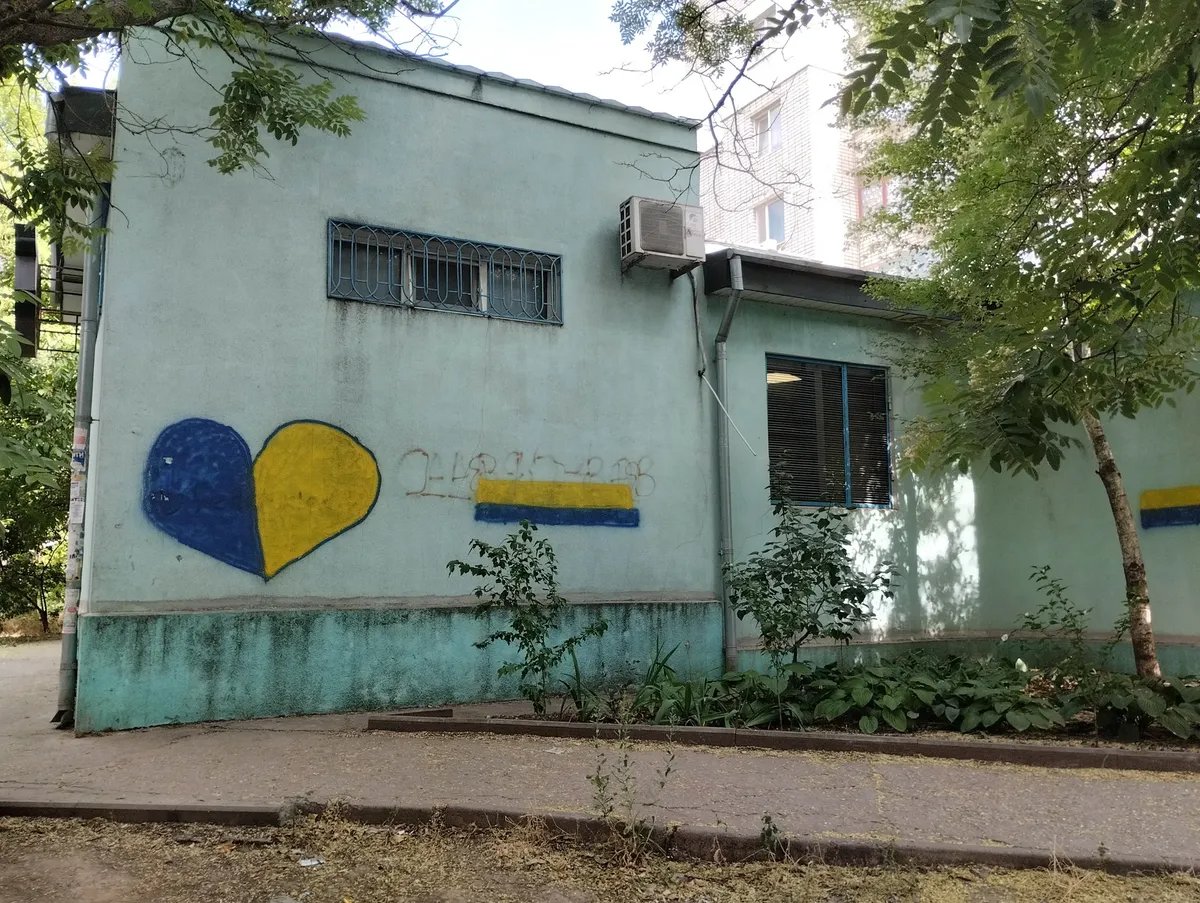
Photo by Elena Bondar
Ukrainian checkpoint Kalanchak is completely destroyed, pieces of concrete are torn out of the buildings, some of them are burnt down. On 24 February, Russian tanks went through this place, obliterating everything on their path. Ukrainian border guards tried to defend their position but were all killed. There are still their burnt down cars, staying idle in the parking lot.
Once you enter the territory of the occupied Kherson region, the first thing you see is a field full of giant non-functioning wind turbines. The road surface is destroyed, so you need to go slow. There is a burnt down truck on the curb. For about 25 miles, we drive along the Pivnichno-Krymskyi Canal. There are a lot of checkpoints here, about ten of them; most are located near pumping stations. Structures made of concrete were built at the checkpoints. They had not been here back in March, when some checkpoints had two soldiers outside, guarding the place. Now, the structures look imposing.
We are stopped at every checkpoint; the soldiers look inside our car and the boot but they only check the driver’s documents.
When we move to a different road — away from the Pivnichno-Krymskyi Canal, there are no more checkpoints. The road signs with names of locations and the distance are painted over with black paint. Closer to Kherson, even regular road signs are painted over — they are impossible to read, a lot have the “Z” symbol on them.
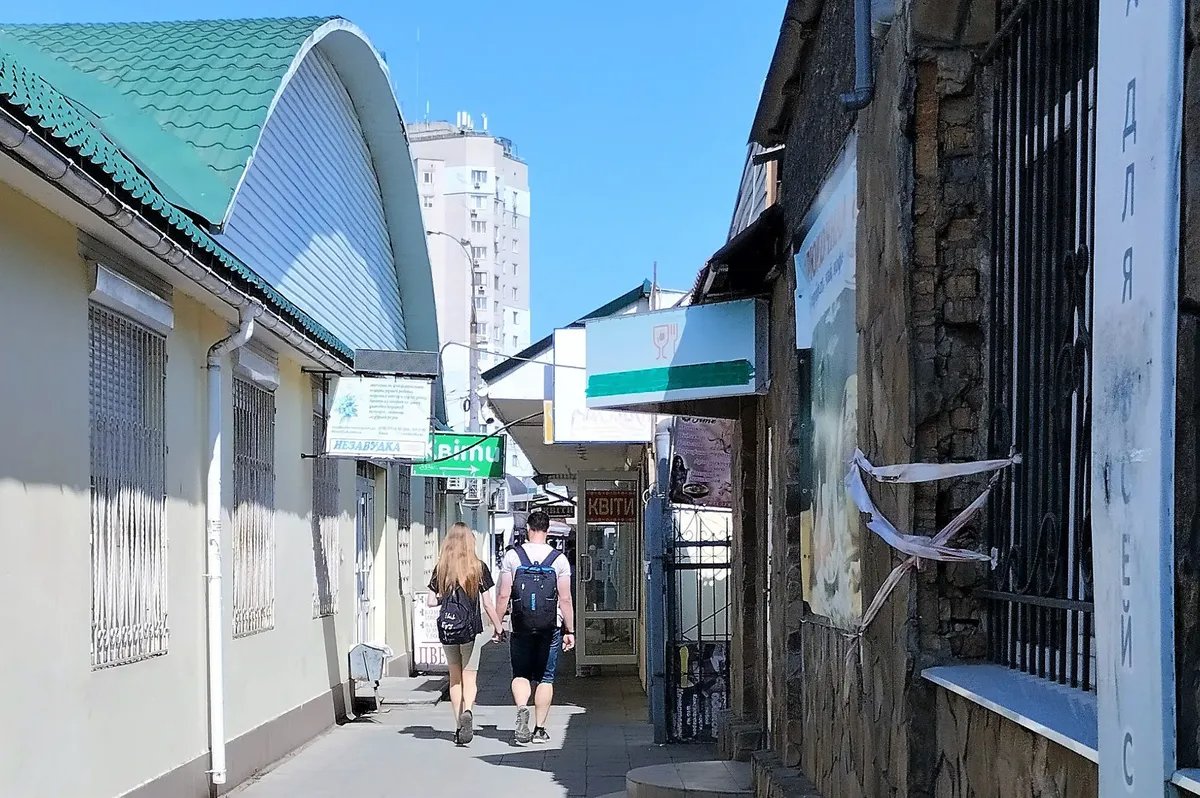
A street in Kherson. Photo by Elena Bondar
The main symbol of the “Russian world” are the stelas that stand on the entrances to cities and villages — they were repainted in the colours of the Russian flag. Although even in Crimea that has been annexed for eight years, there are still a lot of signs in Ukraine’s colours. The biggest welcome sign has not been repainted, it is still yellow-blue, but it was damaged by bullets and shrapnel.
The bridge
Kherson’s pride is the Antonivskyi Bridge that crosses the Dnipro river, it is 4,500 feet long and 82 feet wide. Before it was built in 1985, the locals had to reach the left bank of the Dnipro by river transport or by going through the Kakhovka Hydroelectric Station dam. After the annexation of Crimea, the bridge was mined in case the Russian military attacked, but when the Russian forces actually arrived, the bridge did not blow up.
Today, I can see debris of destroyed cars and burnt military vehicles on the curb of the road that passes through the bridge. There are checkpoints on entry and exit from the bridge. The soldiers inspect every car. Men are asked to take down their shirts and to show their calves — to see if they have any tattoos. We were granted trouble-free passage.
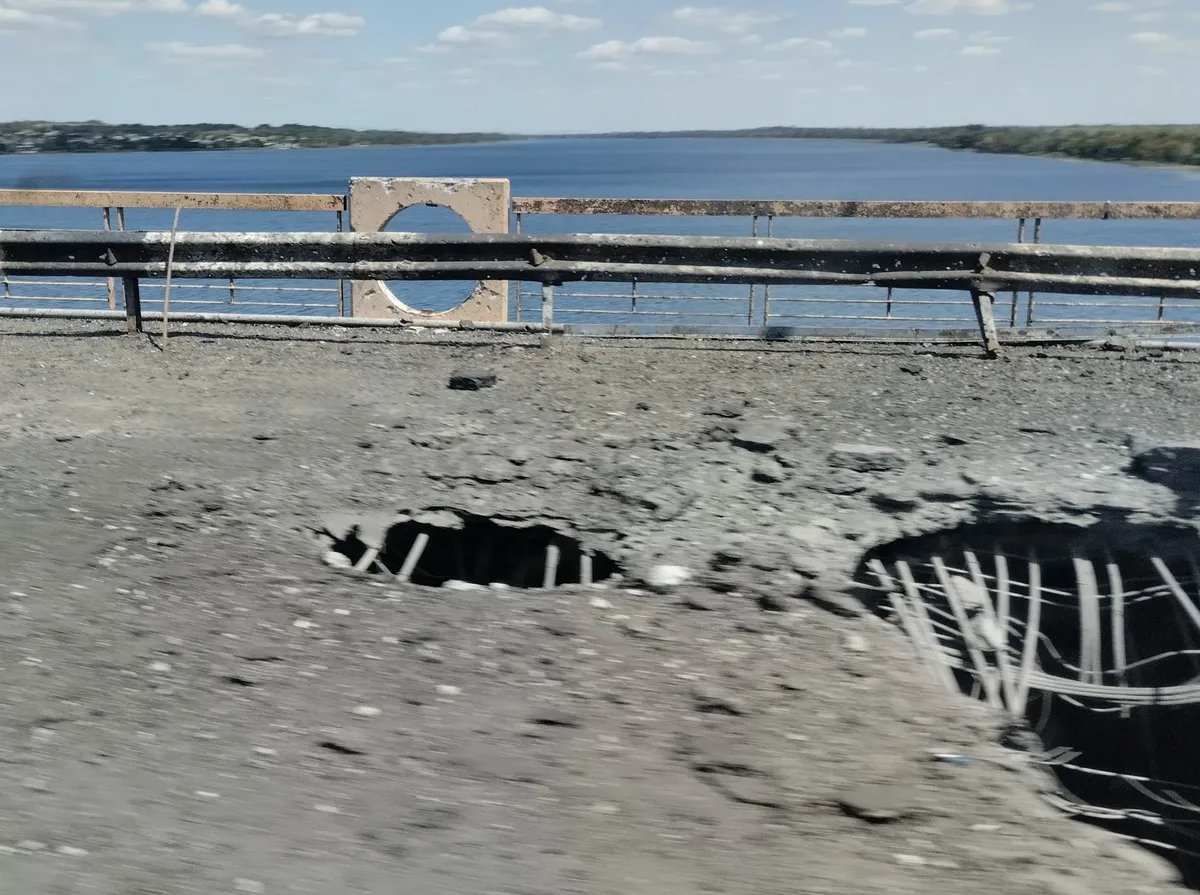
Holes in the Antonivskyi Bridge. Photo by Elena Bondar
“In the morning, the cars weren’t allowed to cross the bridge,” Serhiy, a farmer I know, explains to me. “My wife tried to go to Kherson to hand over potatoes for sale but she wasn’t allowed to cross. By lunchtime, the bridge was open but only for passenger cars. The bridge won’t handle military vehicles after yesterday’s bombing.”
Serhiy carefully drives around the holes in the concrete surface of the bridge. There are eight holes, and they are placed in a way that makes it impossible for a truck to drive through. Local news reported that one of the Ukrainian missiles had hit the Russian base located in a cafe Nairi, on the bridge, but when I was driving by, the cafe looked intact.
Kherson’s outskirts are a suburb with detached housing. The closer the buildings are to the river, the more damage they suffer. The Antonivka and Kindiyka districts suffered heavy damage during in February; today, they continue to be damaged with every bombing of the bridge.
The epicentre
“Look, they are mowing grass in the city, they haven’t done that before,” notes Marya, a resident of Kherson. “They’re probably scared that partisans would hide explosives in tall grass. Their collaborators getting blown up sobered them up. No one here wants the Russian world.”
Marya and I walk past Fabrika, the local mall. There is a McDonald’s sign visible — one of the few left on the burnt wall. The mall was in the top 5 of the biggest Ukrainian shopping centres back in the day. On 1 March, a missile hit the building, and a fire erupted. Russian forces fired at the rescuers from armoured trucks. The locals had to watch the symbol of their prosperous life burn down for several hours.
Across the street stands a hardware superstore Epicentre. Today, a Russian flag waves over it. At the beginning of June, Russian soldiers broke into the building, made the personnel lie down on the floor at gunpoint. The Russian TV loves featuring Epicentre on its channels: the building is intact, and there are a lot of items on the shelves, there are even customers — people need to repair their destroyed houses.
Masha lives near a former educational facility, which keeps her concerned. We quickly walk past the building in silence; there are military vehicles and soldiers on the street. The soldiers’ faces are half-covered with balaclavas. The territory of the facility is now surrounded by a tall fence. There is clearly new barbed wire put above the fence, and we can see people taking down Ukrainian letters from the entrance’s canopy. There are sandbags lying in piles near the windows, the piles reach the first floor. According to Yevhen S. who used to study here in the past, the building could be easily turned into a military base: there is enough room, there is a drill ground and a shooting range in the premises.
“Military vehicles are always coming here,” Marya says. “They keep transporting some cargo. I’m afraid that, one day, a missile will hit this place, just like it hit a Russian base in the neighbouring Nova Kakhovka, and then all of us will suffer.”
In the evening, we drink tea in the kitchen. It gets dark and starts to smell of smoke. Marya rushes to shut the windows.
“Even if it gets very hot, it’s better to shut them,” she explains. “There are, of course, times when fires erupt after a missile strike, but this smell is coming from the landfill. My acquaintance, a retired Internal Affairs Ministry official, told me that the Russian soldiers are burning the corpses of their comrades. It’s so hot outside, and Russians suffered great losses. I heard this theory from many people but haven’t gone to check for myself: the landfill is guarded very well, and it is far away. I do not know what stops them from returning the bodies of their own soldiers to their relatives through Crimea. You can’t dry clothes outside at that time, they get soaked with a pungent smell,” she complains.
Our conversation is interrupted by sudden screams coming from outside, then — a round of gunshots. Silence. Masha serves us more tea.
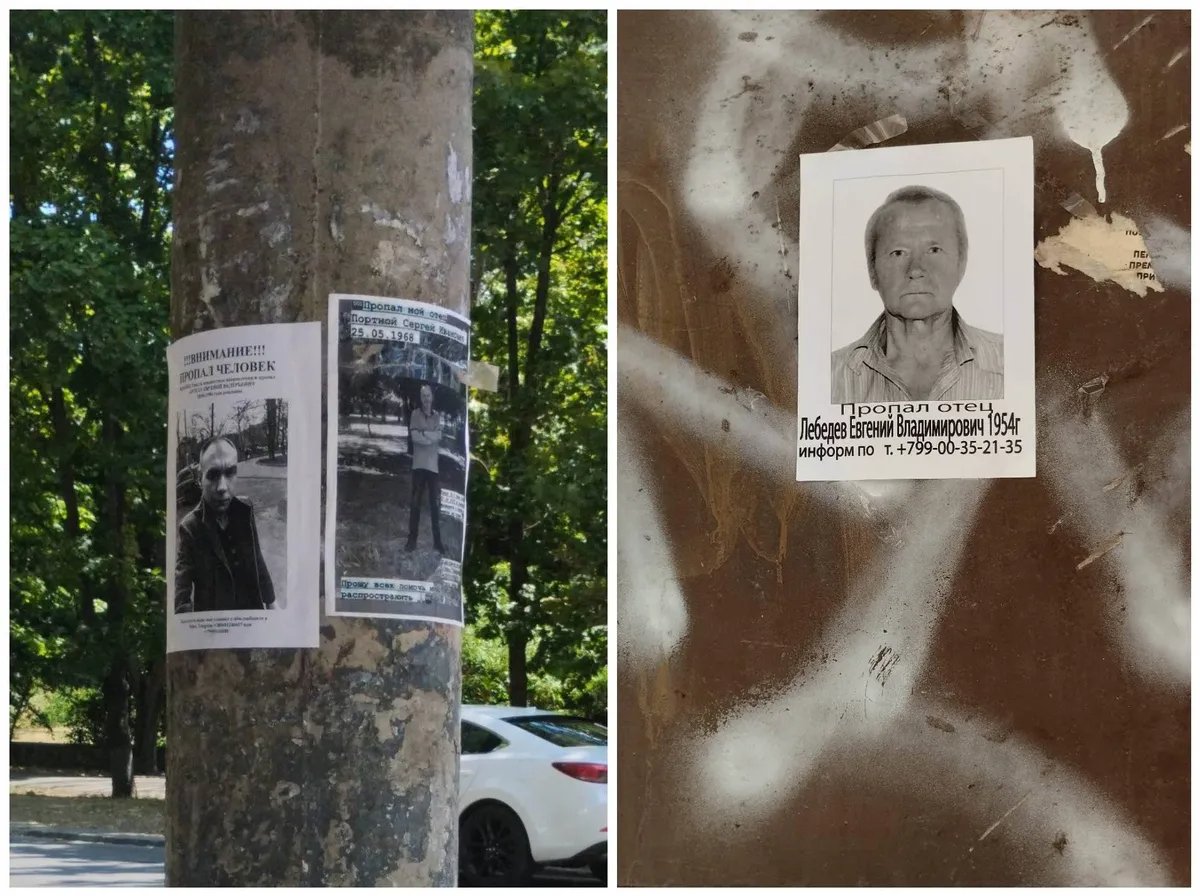
Missing persons ads. Photo by Elena Bondar
“This happens every now and then,” she says. “No one goes outside to check what happened — it’s curfew time. I think that people that survived occupation will take peacetime laws more seriously in the future. We have learned that lawlessness is the hard way.”
The police
The police short dial number, 102, does not work in the Kherson region anymore. After the occupation authorities cut off territories of the Kherson and Zaporizhzhia regions from Ukraine’s Internet and telephone companies, the new emergency numbers were shared via text messengers.
“If you’re a lonely old person who doesn’t have a smartphone, you’ll never going to learn those new ‘denazified’ numbers to call an ambulance, for instance. So, you’ll be doomed to death if you feel sick, you won’t be able to call anywhere,” says Ivan, a former Kherson policeman who refused to work for the new authorities. He was sacked by Ukraine’s Police, too, just like all other police officers who decided to stay in the occupied territory.
Many of his colleagues agreed to work for the new “government”, he says, either after torture or for money. A man named Vladimir Lipandin has been appointed head of the local police. He was placed on the wanted list by Ukraine’s Security Service in 2014 for committing a crime. Lipandin worked as the boss of police in Cherkasy back then, being a strong Russia supporter. He used Berkut riot police against the protesters during the Maidan Uprising. After the protesters prevailed, he fled to Russia, but now his car can be often seen in Kherson. Although some police officers agreed to work for Russia, the occupation “government” is facing a serious shortage of staff anyway. In fact, the lack of employees is so bad that Russia is planning on bringing its own police officers.
“They offer 70,000 rubles (€1,200) to regular officers and an estimate of 90,000 for department leaders, paid in cash,” the former officer continues. “Many of those department leaders had criminal record before the war, mainly for bribery and separatism.”
They are accepted at workplaces with Ukrainian IDs, but they have a priority in the queue for Russian passports.
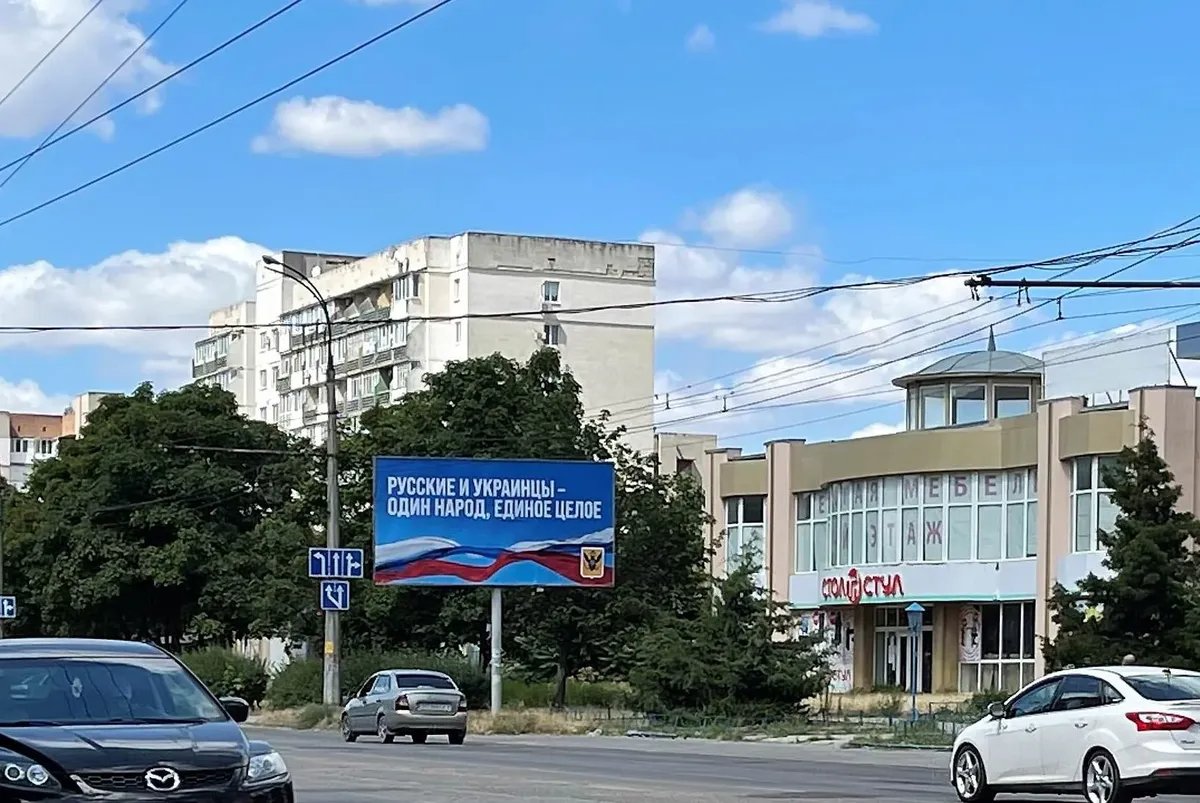
A billboard reading: “Russians and Ukrainians: one people, a single whole”
It now takes about a month for the policemen to become Russian citizens. They are accepted at the local registration office on Saturday, when the office is closed for regular people. They receive their passports much faster than common residents who need to wait about two or three months.
“Russians have actually employed many decent officers who turned their backs on Ukraine. They believe Ukraine walked out on them,” Ivan says. Many of them were waiting to receive their evacuation orders for over month and got it only when there was no safe way to leave the region.
Moreover, Russia’s authorities have handed out weapons to the police officers, and now there’s no need to turn them in once the shift is over.
“Interestingly enough, the worst officers were left behind, too,” Ivan notes. “For instance, one guy started taking cars from the local residents by force and got fired.”
Oleksiy, another former police officer who retired in 2019, says the new authorities brainwash the policemen who agreed to cooperate.
“I asked my former colleague: do you realise that you’re never going anywhere in the world now, you’re never going to see Europe? He said: “I don’t care, I hate ‘em. Why would I care about the wicked West? Take a look at Russia, it’s almost infinite territory.”
After spending time in a basement with Russian torturers, the former colleague of Oleksiy’s is working for the occupation authorities and chants praises for the “Russian world” in all sorts of ways. He used to be a handsome, well-built man in the past, now he wears unwashed clothes, humps his back, has dirt under his fingernails, stutters and covers his mouth when he speaks even though he has all his teeth intact. This is how the locals describe him.
Oleksiy says the Russians captured him in May, too. They broke into his house early in the morning and dragged him out. Then they put a thick hood on his head and drove him to an unknown destination.
They threatened him along the way, said they would connect wires to his testicles.
“It thought my game was over,” Oleksiy recalls. “When we arrived, I recognised where they had taken me, it was a holding cell in our police station. There were four more men in this cell, two had their limbs fractured. I was lucky cause I had retired long before the war started, I had no pro-Ukrainian tattoos, and they found nothing suspicious on my phone.”
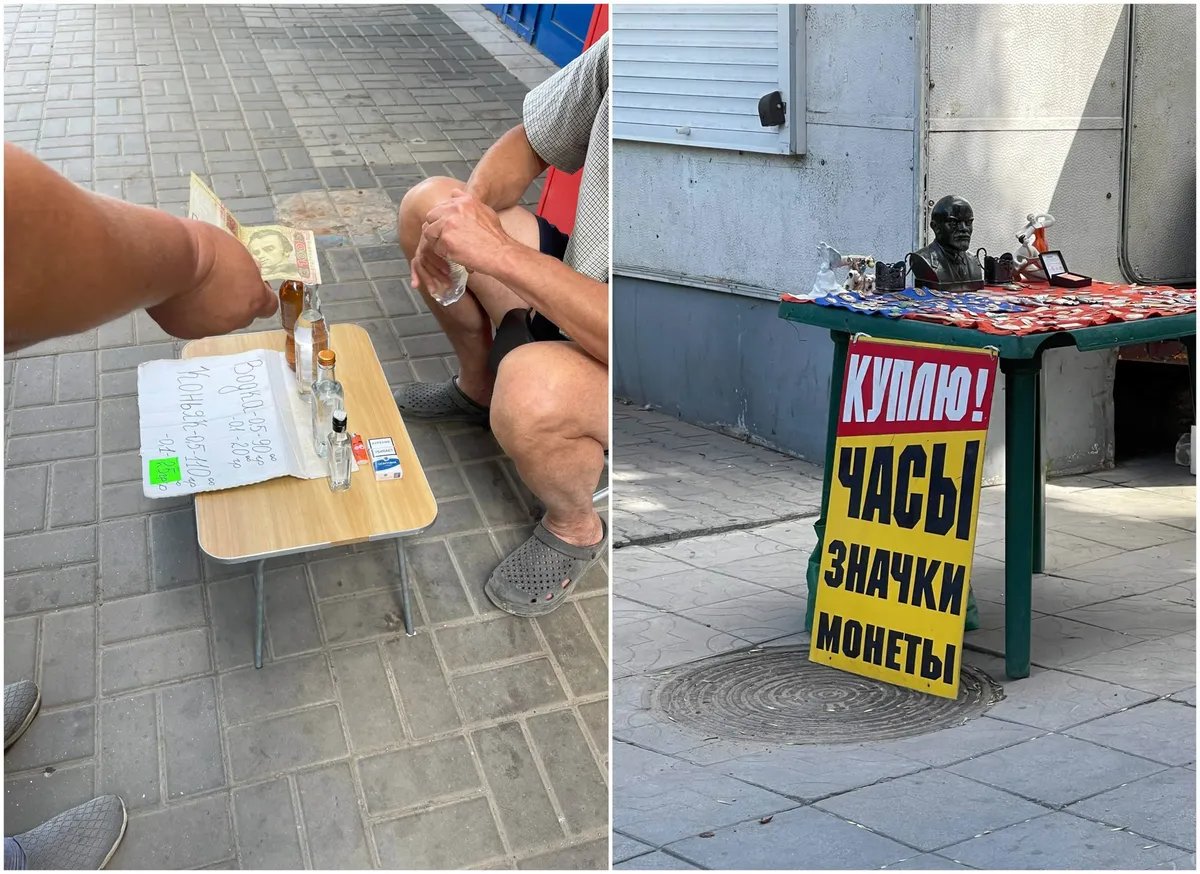
People selling booze in the street. Photo by Elena Bondar
The market
The city’s activity lasts till noon usually, then the locals prefer to stay at home. I’m off to a supermarket, formerly of Ukraine’s ATB retail chain. The billboard has been simply remodelled to “ABC” now. It’s almost as it was before inside: the pointers in the shop are in Ukrainian, although most goods are Russian. The prices have gone up 100% or even 200% since the start of the invasion. They are almost level with the Russian ones, although too high for what Ukrainians are used to.
The price tags are both in rubles and hryvnias, with 1 hryvnia = 1.5 rubles here. Both currencies are accepted by cashiers in cash. You can also pay by card, although Russia-issued cards are useless as they are banned internationally. The cash register issues receipts in rubles, but the computer uses hryvnias, so cashiers need to switch between the two currencies every now and then.
It’s much more exciting at the local improvised market, though.
“The whole city turns into a market in the morning,” explains Vera, 35. “Welcome back to the 90s!”
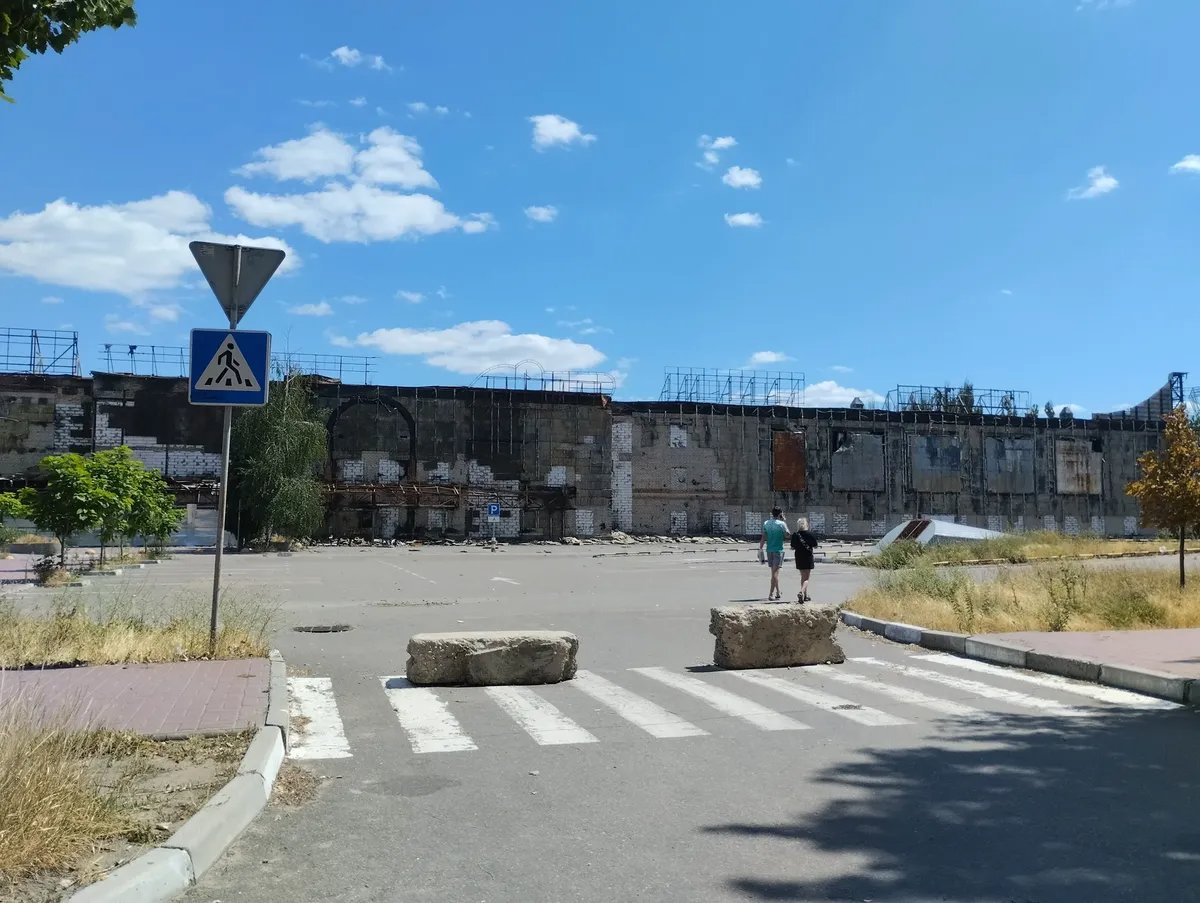
The Fabrika mall was in the top-5 largest malls in Ukraine. It was destroyed by a Russian missile in early March. Photo by Elena Bondar
Countless stalls fill the sun-soaked streets of Kherson. Some people actually sell goods from inside their car trunks. You can buy some milk in the shade, next to the women who sell meat, brushing away flies using a stick from a tree.
Every few feet someone’s selling medicines. The prices offered here are the same as in Russia, but in hryvnias. I’m trying buy some coffee for rubles, but no luck for me this time. The same thing happens to me in a small sausage store where the prices are shown in both currencies as the occupation authorities demand.
“You wish to trade for rubles?” the cashier asks me. “This is possible. Just go outside, you see, there’s a young man standing beside the kiosk. He exchanges rubles for hryvnias, go ahead, I’ll be waiting.”
The guy is indeed there. He offers 580 hryvnias for 1,000 rubles, which is a higher rate than the one the supermarket offers. There is no generally accepted exchange rate here, and the existing one changes rapidly throughout the day. An hour passes, and now 833 hryvnias are offered in exchange for 1,000 rubles. Neither at the market, nor in the small stores did I manage to use Russian rubles, be it cash or card. But this is hardly an issue as every market stall and every car trunk has turned into an exchange point. It shocks me to see the same items being twice or thrice as expensive despite being sold 15-30 feet from each other.
“If there is a cash machine inside the store, it is written on a poster upon entrance so as to keep people from asking,” Vera says. “People are always looking for those. Elders use cards to receive their retirement money, and the public sector employees receive their salaries. Paying by card is now notably pricier than using cash. I can buy a chunk of pork for 180 hryvnias per kg, while a non-cash transaction at the shop would be about 240 hryvnias. The difference might be as huge as 18%. That is, if your retirement payment is 4,000 hryvnias, you’ll need to pay 720 for turning it into cash. Some shops who accept cards have introduced cash-conversion fees; they say this is because they are forced to go and cash the money out in order to buy the goods. If you have internet connection, you may pay by a C2C transaction, showing your phone’s screen to the cashier to confirm the payment. For instance, if I buy 300 hryvnias worth of goods, I need to pay 5-10% on top of it.”
Vera is certain that those whose sell pet food make most money. She used to buy wet food for her cat for 5 hryvnias a pack before the war; now the price is three times as high (and it used to be 30 hryvnias in the first couple of months after the invasion started).
“When the war began, I needed to save my dog who had diabetes,” Vera recalls. “I used to walk many miles around the city each day to buy some insulin and some syringes. The local chatrooms were really helpful; people would exchange medicines online. Sometimes I would get the insulin I needed. I managed to get the medicines, but the dog food was a real problem. So, the old Nika died recently, so I grabbed my shovel and I buried her in my garden. I rather she was buried somewhere in the field, but it’s too dangerous to go there now because of the snipers and the land mines.”
Natalia, a merchant, sells homewares for rubles and hryvnias, but prefer the latter. She says she will keep paying her taxes to Ukraine until the occupation authorities get her cornered. Natalia heard that the Russians demand that all residents sign up for their tax agency, but she received no official notice, so she keeps selling her goods “bit by bit.”
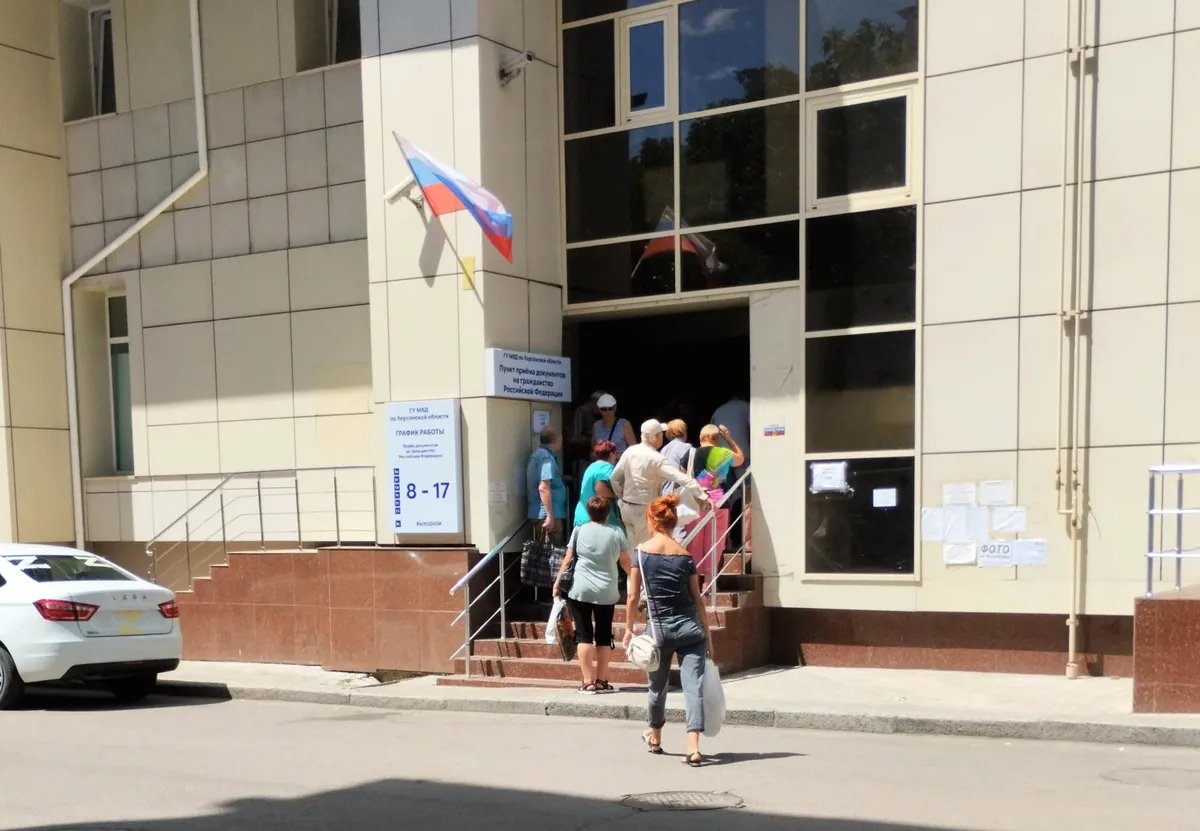
The registration office where locals obtain their Russian passports Photo by Elena Bondar
Double dipping
I am in the heart of the city now. The flags of Russia, USSR, and “DPR” are hoisted atop the public buildings. On each side of the local city hall are concrete fortifications with holes just enough to fit an AK barrel. Military men and vehicles with “Z”s on them are all over the place.
There is a crowd on top of the staircase leading to the local courthouse: people come here to learn about what happened to their kidnapped relatives. There are posters of people who went missing glued to the lampposts nearby.
There is a separate queue, mostly of elders, waiting to receive their Russian IDs.
“They said on the TV that Ukraine would no longer pay us our retirement money, and if you hesitate long enough, you won’t get it from Russia as well,” says Vasyl, one of the elders. Obviously, no channels other than the Russian ones are available on the TV.
“But Ukraine said they would still pay those,” I reply as I try to have an objection.
“I don’t care. I’m Russian. If they pay, I’m getting some use of it.”
“If you’re signing up for Russia’s retirement money, have you filed a paper that you opt out of Ukraine’s?”
“Fat chance!” Vasyl is getting agitated. “The elders in Donbas have been getting money from both sides, am I any worse?”
Another group of people is queuing up for the Russian welfare payout of 10,000 rubles (€170). This is a monthly payout, but one needs to queue twice each month: once to sign up for it and once more to receive the cash.
“Some of the people I know have received the 10 grand, but I don’t want it,” says Lidia, another elder. “I have enough noodles and grains to last until Ukraine comes to liberate us. And if I don’t make it... Well, so be it. I don’t need any handouts from the invaders.”
An old Leninite
Me and Petro, a local old man, are sitting on top of crates in his spacious basement, drinking homemade wine. Petro has a solid house, there is not a single weed in his vegetable patch, but his basement is what he must be truly proud of: it’s all filled with 10-litre bottles with wine and moonshine. There is a separate shelf for crates with grain and vegetables. In the corner there is an electric stove, and a water tap right beside it. There are two exits from the basement, and it appears to be a perfect place to hide from shelling.
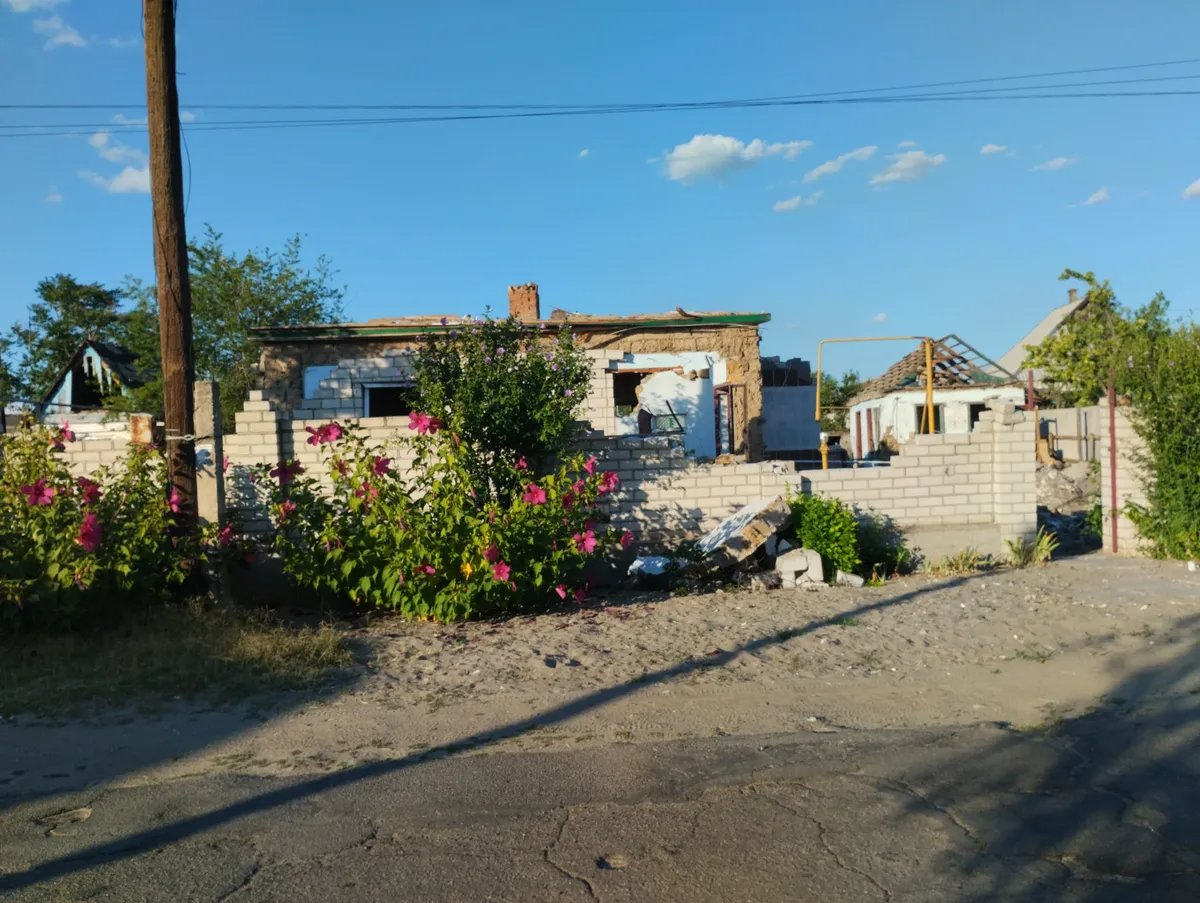
The house that suffered a missile strike. Photo by Elena Bondar
Petro lives in a detached housing area which suffered a missile strike only once, though several houses were destroyed. Other houses only had their windows smashed, but luckily no one was killed.
“These Banderites attempted to hit a Russian base here,” Petro, a 100% Ukrainian, explains to me in Surzhyk, a mixed Russian-Ukrainian dialect. His ancestors had to escape Central Ukraine a hundred years ago as the Soviet regime persecuted kulaks, the wealthy peasants, to the badlands of the south where they took a foothold. “I don’t get why Ukraine’s army still aim their missiles at us. Forget about Ukraine, Russia’s here forever. And I’m Russian.”
Petro downs another glass of wine and gets totally wound up.
“What should I be grateful to Ukraine for?” he asks as he gets more and more agitated. “Why did they remove Lenin’s statue from the city square? What’s wrong about Lenin? He’s part of our history.”
A portrait of Vladimir Lenin can be seen behind Petro’s back as an old dim light bulb, which Russians often associate with Lenin, lights the basement. The portrait is embroidered on red calico with gilded stitches and has Lenin’s cliché about “catching up and taking the lead” written on it.
The sounds of explosion can be heard at times: Russia’s military is launching its missiles against the city of Mykolaiv.
“They used to trench about before, but now they act smarter. They bring their rocket launchers, fire five or six missiles and leave the place at full speed,” explains Petro. “The locals swear at them up hill and down dale, even those who support Russia. They are afraid that Ukraine’s counter shelling might hit their houses. Look, I don’t get why niggle with those Banderites, I wish we could just nuke them, don’t you agree?”
Petro pours out Russia’s propaganda clichés: about the “eight years,” about the glorious Russia, and, of course, the wicked America. He is proud to say that the TV is for common men, and his sources are way more reliable. It turns out he’s been watching Anatoly Shariy’s “military and political analytics” on YouTube for over a year. Shariy is a YouTuber who is considered pro-Russian by many Ukrainians. He was detained in Spain upon request of Ukraine’s authorities in May 2022 but was released under certain conditions.
Petro admires Russians, although he has that one bad apple that spoils the whole barrel. Mykhailo, an old pal of Petro’s, was kidnapped by Russians one morning. Mykhailo used to be a small thug back in the 90s, and Russia’s security wished to learn from him how drug smuggling is done in the region. He knew nothing of course, as he has long been retired.
“I thought they were willing to wipe out drug trafficking here, but in fact they simply wanted to steal this business,” Petro says wonderingly. “They tortured my buddy, broke his ribs and one of his legs. They wouldn’t let him go to the loo for several days, then they threw him out of their car near his house and stole his off-roader. But I think it was just an accident, wasn’t it? I believe they’re fine fellas after all.”
P.S.
I left Kherson on 26 July, a few hours before the Antonivskyi Bridge was destroyed, and Kherson became besieged.
Делайте «Новую» вместе с нами!
В России введена военная цензура. Независимая журналистика под запретом. В этих условиях делать расследования из России и о России становится не просто сложнее, но и опаснее. Но мы продолжаем работу, потому что знаем, что наши читатели остаются свободными людьми. «Новая газета Европа» отчитывается только перед вами и зависит только от вас. Помогите нам оставаться антидотом от диктатуры — поддержите нас деньгами.
By clicking the Support button, you agree to the processing of your personal data.
To cancel a regular donation, please write to [email protected]
